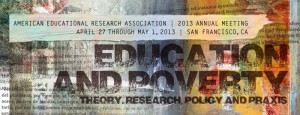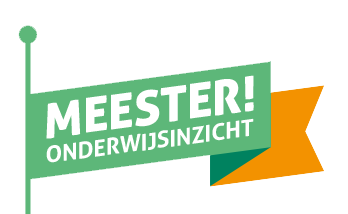 Below my presentation, abstract, paper and references for my part of the invited VOR symposium at AERA 2013 in San Francisco.
Below my presentation, abstract, paper and references for my part of the invited VOR symposium at AERA 2013 in San Francisco.
Cite as:
Integration of academic and vocational disciplines in simulated practice
Presentation: AERA_2013_MVS_web of reasons
Abstract
In vocational education students are to be prepared to participate in communities of practice (Maes, 2004). Hence they need technical skills as well as content knowledge e.g. science and mathematics. Research has shown that the instructional strategy of guided co-construction may lead to deeper understandings within a practice (Van Schaik, Van Oers & Terwel, 2010/2011; Snel, Terwel, Aarnoutse & Van Leeuwen, 2012). Guiding in a co-constructive way means helping students to collaboratively reconstruct models and subject matter knowledge through an on-going and reciprocal discursive process, focused on the solution of task-related problems (Mercer, 1995; Hardman, 2008). This paper focusses on students’ drawings and models and their function in a ‘web of reasons’ (Brandom, 1994). The present research takes a cultural historical activity theory perspective on how students (age 14-16) and their vocational and subject matter teachers use models and other representations as tools in the process of designing and constructing (Van Oers, 2006; Billet, 2003). We use video data from a design based research project at schools for preparatory senior secondary education, for which students had to design and built a prototype of a tandem tricycle. Teachers guided the students in this process aiming at not only acquiring technical skills, but also at an understanding of codified knowledge (Van Schaik, et all, 2010/2011).
The present research explores how the models functioned for the students in the simulated workplaces at school as reasons for action and how these reasons evolve over time and through guidance of the teacher. From a body of about 10 hours of video data we selected 18 interactions of students and teachers on or over their models and drawings from early in their design and construction process till the end. By identifying the change of meaning and the role the representations play in students’ web of reasons, we can explain students’ (differences in) understanding of models and concepts of mathematics and science. The results showed that students’ actions, tool use and products concepts and knowledge play an important roll as object-motives (Edwards, 2010).
We propose that emphasis should be on the inferential role of concepts and representations in order for the students to be meaningful and to be used as tools in a practical way (Bakker & Derry, 2011). This proposition may help to bridge the gap that exists for students and teachers in vocational education between practical, explicit, situated knowledge and codified, general knowledge. Hence integrating the vocational and academic disciplines. Moreover, a web of reasons can be a pedagogical tool for teachers within a strategy of guided co-construction.
Keywords: modeling, co-construction, models, vocational education, web of reasons
VanSchaik_Integration of academic and vocational disciplines in simulated practice_donotcite
References
Barab, S., & Squire, K. (2004). Design-based research: putting a stake in the ground. The journal of the learning sciences, 13(1), 1-14.
Beach, K. (2007). Consequential transitions: a developmental view of knowledge propagation through social organizations. In: T. Tuomi-Gröhn & Y. Engeström (Eds.), Between school and work New perspectives on transfer and boundary crossing, Advances in learning and instruction series. Amsterdam: Pergamon.
Cedefop. (2009). Future skill supply in Europe. Medium-term forecast up to 2020. Luxembourg: Office for Official publications of the European Communities. Retrieved from http://www.cedefop.europa.eu/etv/Upload/Information_resources/Bookshop/546/4086_en.pdf
Clarke, D. (2004). Researching classroom learning and learning classroom research. The mathematics educator, 14(2), 2-6.
Cobb, P., Confrey, J., diSessa, A., Lehrer, R., & Schauble, L. (2003). Design Experiments in educational research. Educational researcher, 32(1), 9-13.
Collins, A., Joseph, D., & Bielaczyc, K. (2004). Design research: theoretical and methodological issues. Journal of the Learning Sciences, 13(1), 15-42.
Commission of the European communities. (2008). Improving competences for the 21st century: An Agenda for European cooperation on schools (Communication from the commission to the European parliament, the council, the European economic and social committee and the committee of the regions No. SEC (2008) 2177). Brussels: Commission of the European communities. Retrieved from http://eur-lex.europa.eu/LexUriServ/LexUriServ.do?uri=COM:2008:0425:FIN:NL:PDF
Doorman, L. (2005). modeling motion: from trace graphs to instantaneous change. Utrecht: CD-B press.
Downing-Wilson, D., Lecusay, R., & Cole, M.(in press). Design experiments and mutual appropriation: two strategies for university/community collaboration after school interventions. Theory & Psychology.
Engeström, Y. (2007). Putting Vygotsky to work. The change laboratory as an application of double stimulation. In: H. Daniels, M. Cole, & J. Wertsch (Eds.), The Cambridge companion to Vygotsky (pp. 363-382). New York: Cambridge University Press.
Engestrom, Y. (2009). The future of activity theory; a rough draft. In: A. Sannino, H. Daniels, & K. Gutiérrez (Eds.), Learning and expanding with activity theory (pp. 303-328). New York: Cambridge University Press.
Eraut, M. (2004). Transfer of knowledge between settings. In: H. Rainbird, H. Fuller, & A. Munro (Eds.), Workplace learning in context (pp. 201-221). London: Cambridge University Press.
Erickson, F. (2006). Definition and analysis of data from videotape: some research procedures and their rationales. In: J. L. Green, G. Camilli, & P. B. Elmore (Eds.), Handbook of complementary methods in education research (pp. 177–192). Mahwah, New Jersey: Lawrence Erlbaum associates, Inc. Publishers American Educational Research Association.
Eurydice. (2008). Organisation of the education system in the Netherlands. The Hague: Ministry of Education, culture and science. Retrieved from http://eacea.ec.europa.eu/education/eurydice/documents/eurybase/eurybase_full_reports/NL_EN.pdf
Goodlad, J., Klein, M., & Tye, K. (1979). The domains of curriculum and their study. In: J. Goodlad (Ed.), Curriculum Inquiry. The study of curriculum practice (pp. 43-76). New York, St. Louis, San Francisco: McGraw-Hill Book Company.
Gresalfi, M. S. (2009). Taking Up Opportunities to Learn: Constructing Dispositions in Mathematics Classrooms. Journal of the Learning Sciences, 18(3), 327-369.
Guile, D., & Griffiths, T. (2001). Learning Through Work Experience. Journal of Education and Work, 14(1), 113-131.
Guile, D., & Young, M. (2003). Transfer and transition in vocational education: some theoretical considerations. In: T. Tuomi-Gröhn & Y. Engestrom (Eds.), Between school and work: new perspectives on transfer and boundary crossing (pp. 63-84). Advances in learning and instruction series. Amsterdam: Pergamon.
Huisman, J., De Bruijn, E., Baartman, L. K. J., Zitter, I. I., & Aalsma, E. (2010). Leren in hybride leeromgevingen in het beroepsonderwijs. [Learning in hybrid learning environments in vocational education]. ’s Hertogenbosch: ECBO.
Koopman, M., Teune,, P., & Beijaard, D. (in press ). Development of student knowledge in competence-based pre-vocational education. Learning environments research.
Lave, W., & Wenger, E. (2005). Practice, person, social world. In: H. Daniels (Ed.), An introduction to Vygotsky (Vol. 2, pp. 149-156). East Sussex: Routledge.
Lemke, J. L.., & Sabelli, N. H.. (2008). Complex Systems and Educational Change: Towards a new research agenda. Educational Philosophy and Theory, 40, 118-129. doi: doi:10.1111/j.1469-5812.2007.00401.x
MacDonald, D., & Gustafson, B. (2004). The role of design drawing among children engaged in parachute building activity. Journal of technology education, 16(1), 55-71.
Maes, M. (2004). Vocational education and training in the Netherlands. Cedefop Panorama series (Revised Edition.). Luxembourg: CEDEFOP (European Centre for the Development of Vocational Training). Retrieved from http://www.blackboard.uu.nl/@@06DE8A9E49CE8D30A6D5BACA5EE8F96B/courses/1/AIO_netwerk_BO/content/_304211_1/Cedefop_2004_Vocational%20education%20and%20training%20in%20the%20Netherlands.pdf
Mercer, N. (2002). Developing Dialogues. In: G. Wells & G. Claxton (Eds.), Learning for life in de 21st Century. Sociocultural perspectives on the future of education (pp. 141-153). Oxford: Blackwell Publishers Ltd.
Raven, J., Raven, J., & Court, J. (2000). Standard progressive matrices. Manual for Raven’s progressive matrices and vocabulary scales. Oxford Psychologists.
Ruthven, K., Laborde, C., Leach, J., & Tiberghien, A. (2009). Design Tools in Didactical Research: Instrumenting the Epistemological and Cognitive Aspects of the Design of Teaching Sequences. Educational Researcher, 38(5), 329-342.
Schaap, H., Baartman, L., & Bruijn, E. (2011). Students’ Learning Processes during School-Based Learning and Workplace Learning in Vocational Education: A Review. Vocations and Learning. doi: 10.1007/s12186-011-9069-2
Seezink, A., & Van der Sanden, J. (2005). Lerend werken in de docentenwerkplaats: Praktijktheorieen van docenten over competentiegericht voorbereidend middelbaar beroepsonderwijs. [Intergrating acquisition and participation: an exploration of teachers’ individal action theories]. Pedagogische studien, 82(4), 275-289.
Shavelson, R., Phillips, D., Towne, L., & Feuer, M. (2003). On the science of education design studies. Educational Researcher, 32(1), 25-28.
Snyder, J., Bolin, F., & Zumwalt, K. (1992). Curriculum implementation. In: P. Jackson (Ed.), Handbook of research on curriculum (pp. 402-435). New York: Macmillan publishing company.
Stevens, R., & Hall, R. (1998). Disciplined perception: learning to see in technoscience. In: M. Lampert & M. L. Blunk (Eds.), Talking mathematics in school. Studies of teaching and learning (pp. 107-149). Cambridge: Cambrigde University press. Retrieved from http://faculty.washington.edu/reedstev/Stevens&Hall_disciplined_perception.pdf
Terwel, J., Van Oers, B., Van Dijk, I., & Van Eeden, P. (2009). The learner as a designer: effects on transfer of an experimental curriculum in modeling. Educational research and Evaluation, 15(1), 25-44.
The design based research collective. (2003). Design based research: an emerging paradigm for educational inquiry. Educational researcher, 32(1), 5-8.
Tuomi-Gröhm, T., & Engeström, Y. (2003). Conceptualizing transfer: form standard notions to developmental perspectives. In: T. Tuomi-Gröhn & Y. Engeström (Eds.), Between school and work New perspectives on transfer and boundary crossing, Advances in learning and instruction series (pp. 19-38). Bingley: Emerald Group publishing Limited.
Tynjälä, P. (2008). Perspectives into learning at the workplace. Educational Research Review, 3(2), 130-154. doi: 10.1016/j.edurev.2007.12.001
Van der Sanden, J., Terwel, J., & Vosniadou, S. (2000). New learning in science and technology. In: P. Simons, J. Van der Linden, & T. Duffy (Eds.), New Learning: three ways to learn in a new balance (pp. 119-140). Dordrecht: Kluwer Academic Publishers.
Van Dijk, I., Van Oers, B., & Terwel, J. (2003). Providing or designing? Constructing models in primary maths education. Learning and Instruction, 13(1), 53-72.
Van Oers, B. (1988). Modellen en de ontwikkeling van het (natuur-) wetenschappelijk denken van leerlingen.[Models and the development of (natural) scientific thinking of students]. Tijdschrift voor Didactiek de Beta-wetenschappen [Journal of didactics for the beta-sciences], 6(2), 115-143.
Van Schaik, M. (2009). Looking at learning in practice – Classroom observation with Noldus Observer XT. Noldus. Retrieved from http://www.noldus.com/documentation/looking-learning-practice-classroom-observation-noldus-observer-xt
Van Schaik, M., Van Oers, B., & Terwel, J. (2011). Towards a knowledge-rich learning environment in preparatory secondary education. British Educational Research Journal, 37(1), 61–81. doi: 10.1080/01411920903420008
Van Schaik, M., Van Oers, B., & Terwel, J. (2010a). Learning in the school workplace: knowledge acquisition and modelling in preparatory vocational secondary education. Journal of Vocational Education & Training, 62(2), 163–181. doi: 10.1080/13636820.2010.484629
Van Schaik, M., Terwel, J., & Van Oers, B. (2010b). Tools for learning in simulated workplaces: results of an intervention in vocational education. Co-constructing models as tools in vocational practice. Learning in a knowledge-rich environment (pp. 86–106). Zoetermeer: Free Musketeers.
Van Schaik, M., Terwel, J., & Van Oers, B. (in press). Representations in simulated workplaces.
Volman, M. (2006). Jongleren tussen traditie en toekomst [Juggling between tradition and future] Inaugural lecture. Centre for Education Training, Assessment and Research,VU University Amsterdam.
Weinstein, M. (2006). TAMS Analyzer Anthropology as Cultural Critique in a Digital Age. Social Science Computer Review, 24(1), 68–77. doi: 10.1177/0894439305281496
Zitter, I., de Bruijn, E., Simons, R. J., & Ten Cate, O. (2011). Adding a design perspective to study learning environments in higher professional education. Higher Education, 61, 371–386.

